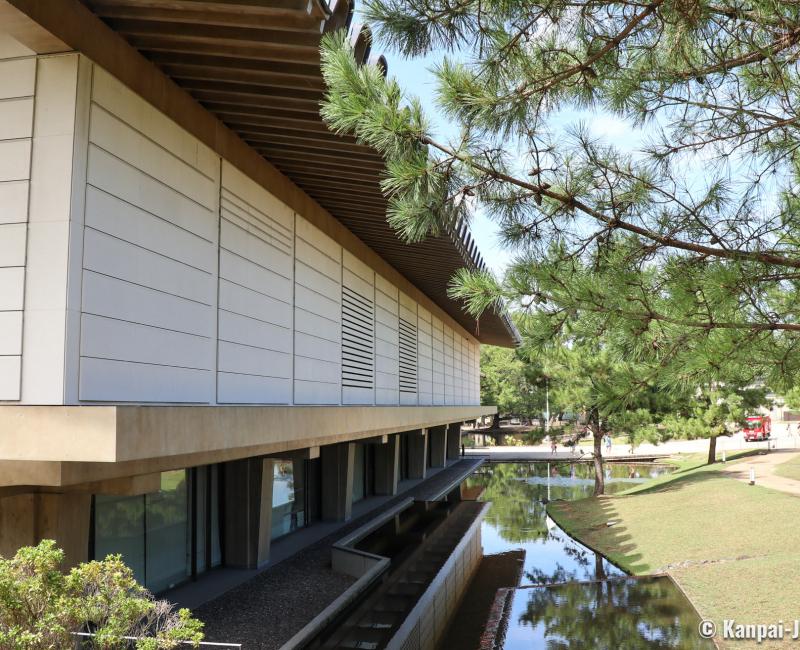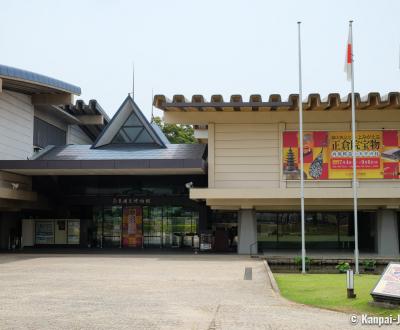Nara National Museum
The Buddhist Art Specialist
Nara National Museum is a four-building exhibition complex in the historical center of Nara. Only a few minutes’ walk away from Todai-ji’s Great Buddha, the museum shelters a beautiful collection of Buddhist artworks, including bronze sculptures.
In the same manner as its counterparts in Tokyo and Kyoto, Nara National Museum is divided into several buildings whose architectural styles are reminders of the periods during which they were constructed. As far as Nara’s museum is concerned, there are 4 exhibition halls:
- The Nara Buddhist Sculpture Hall (permanent collection) in the main original brick building of western-style architecture, completed in 1894,
- The Ritual Bronzes Gallery (permanent collection) with 380 Chinese artworks displayed since 1937,
- The West Wing (permanent collection and temporary exhibitions), a concrete building defined by its pure lines dating back to 1972, and,
- Its counterpart, the East Wing (temporary exhibition) inaugurated in 1998.
The museum compounds also include a tea pavilion (only accessible during ongoing exhibitions in the East Wing), a specialized library and a Conservation Center for Restoration and Conservation of National Treasures, created in 2002 but not open to the public.

One of Japan’s first national museums
At the beginning of Meiji Era (1868 - 1912), many great changes were on the way in Japan while the country was gradually opening to the world. Buddhism was declining and scattering of the temples’ treasures subsequently ensued. The government therefore decided to enforce a policy to protect the religious and cultural heritage. Thus, Nara National Museum was founded on 1895, April 29, and initially named "Nara Imperial Museum." It was the second of its kind, after Tokyo National Museum.
Until 1945, a large part of Nara’s temples and shrines artworks were preserved in the museum that was comparable to a safe. After WWII, the religious establishments developed their own conservation centers, and many cultural objects were de facto returned to their original sites.
A perfectly preserved Buddhist heritage
This museum is labelled an expert of Buddhist art thanks to its impressive collection of Buddhist statues covering various historical periods, whose most ancient date back to the 8th century. The museum offers an understanding of:
- The evolution of Buddhist representations throughout the centuries,
- The various types of materials used, such as clay, wood, or bronze, and,
- The artistic skills and technical know-how of the sculptors.
For example, one of the remarkable displays is a wonderfully detailed wooden Buddha sculpture that is only 3 centimeters high.
Nara National Museum’s permanent collection also includes calligraphy rolls and samurais' armors.
Various temporary expositions are staged throughout the year, but there is one seasonal event that is not to be missed: the exhibition of Shoso-in Treasures. Each autumn 🍁 and for 17 days, a unique collection of the temple’s artworks is displayed, and it will not be disclosed again in the next ten years. It is certainly the museum’s most popular temporary exhibition.
On a side note: pictures are strictly forbidden inside the buildings, and the English translations of the panels are less detailed than in Japanese. Those who are passionate about Buddhism may choose to rent an audio guide at the entrance of the museum or hire a private guide to be given more thorough explanations.
The museum is not a must-see in Nara, but its indoor visit is a lot quieter and gives another insight than the famous temples and shrines of the city.


